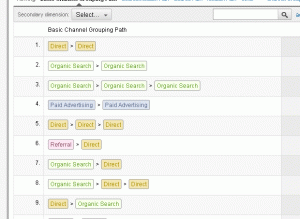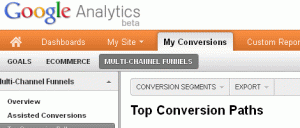You cannot manage what you do not measure.
This single phrase simply can’t be ignored. Without measurement there is no gauge on progress and it becomes virtually impossible to determine if your efforts are effective at building your business and reaching your goals.
Despite this, I find it incredibly stunning how many business do not take full advantage of the analytic suites available to them. They install what they call ‘tracking’ when in fact, the information they are recording means little to maximizing the effectiveness of there overall objectives.
More specifically, determining how effective a particular channel of the business is often requires tracking visitors through what is called a funnel. In a funnel, the visitor enters at a specific point and is guided toward an end objective. That objective can be anything; a download, a contact us request, or in ecommerce—ideally a sale.
However, a visitor seldom follows a perfect liner path to a conversion. More often they start at one point, go through a series of channels along the way called micro-conversions, go back to a few earlier channels (or find new channels), then complete the final objective—the macro conversion. Each of the micro conversions play a role in the macro conversion, without them, the macro conversion doesn’t happen.
Understanding what micro conversions—or points along the way—they took to complete the objective is critical in fine tuning your marketing efforts at each step. Tracking only the last contact point of the funnel (i.e. the last page or ad the user clicked before they reached the site which in turn lead to the conversion) vs. tracking every point along the way is ineffective and leaves a lot on the table.
Let me illustrate using the following example. A visitor clicks your PPC ad but then after arriving at your site leaves at some point and does not complete the sale. They come across your Facebook page a week later, look over that, then take an offer you had on the page to download more information about a specific product via an email optin—and they leave again.
A week after that they read over the info about the product and click a bookmark they had made of your site upon one of their initial visits. This time they decide to make the purchase.
If you were only tracking from the final entry point to the end conversion you would believe that this conversion originated from a ‘direct referral’ such as a bookmark, by directly tying it into the address bar, or by another similar method—and that is true to a certain extent. The conversion did come after the directly linked to the site, but that was not where the funnel truly started.
You see, the way your customers interact with your entire sales channel, not just part of it, leads to what happens in the end. If you knew exactly which channels they interacted with before they reached the final point leading to a conversion, you could setup more fine tuned marketing efforts at each stop along the way.
Thanks to Google’s introduction of multi-channel sales funnels, the landscape has changed and we are now able to see a more complete representation of the exact path—and even timeframe—taken to a given conversion (in our example 3 weeks from beginning to end.)

Multi-channel sales funnels include tracking for but not limited to:
- Paid and organic search (for all search engines)
- Referral sites
- Affiliates
- Social networks
- Email newsletters
- Display ads
- Custom campaigns that you’ve created, including offline campaigns that send traffic to vanity URLs
- And more …
With this new information in front of you it is now possible to see that in fact the first contact with this new customer in our example came through your PPC advertising and not through the direct link alone—and this was approximately 3 weeks prior to the actual conversion occurring. Although initial visit did not produce a sale, it did get them interested enough to get to know your company further (through your Facebook page) and in turn, the information they downloaded after opting in to your email was what might have finally pushed them to come back (through the bookmark) and eventually buy.
Armed with this detail, you can now see that without the PPC they likely would not have started the process, and without the information you presented them with for download, they may have gone elsewhere. So each step in the process was an integral part of them making a purchase.
How do you setup and use the multi-channel sales funnels?
You don’t really need to setup multi-channel sales funnels in Google Analytics—they are a set of reports. However, although you do not need to setup anything in particular that directly relates to the reports, you do need a few things active within your Analytics account for the reports to be made available to you.
- You must have either Goals, or Ecommerce Tracking turned on for your website.
- You must be using the new version of Google Analytics (click the “New Version” link from your Analytics dashboard to activate it.)

- Once you’ve got those two items in place, you should now see a new tab called “My Conversions” at the top of your page within Google Analytics. Use that tab to navigate to the multi-channel funnels area.

- For even more detailed information about your advertising campaigns make sure you link your AdWords account to your Analytics account.
More often than not, those who become customers don’t simply follow a straight line path to a resulting conversion. With the various channels available to them today they may click an ad, visit one of your social media pages, follow your tweets, read your emails, and more. If you knew precisely the route they took to generate the final conversion you have more power to optimize your marketing at each point along the way—increasing your opportunity of closing more sales. That’s what multi-channel sales funnels do for your business.